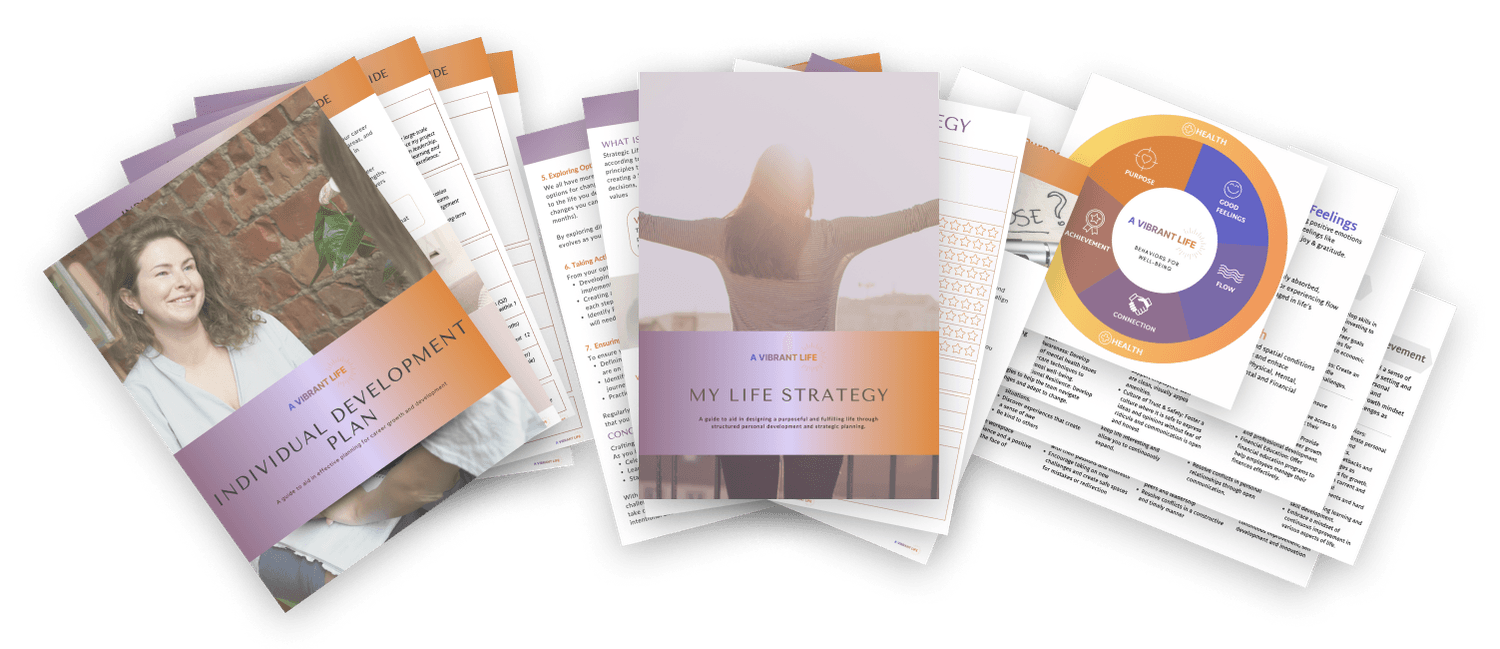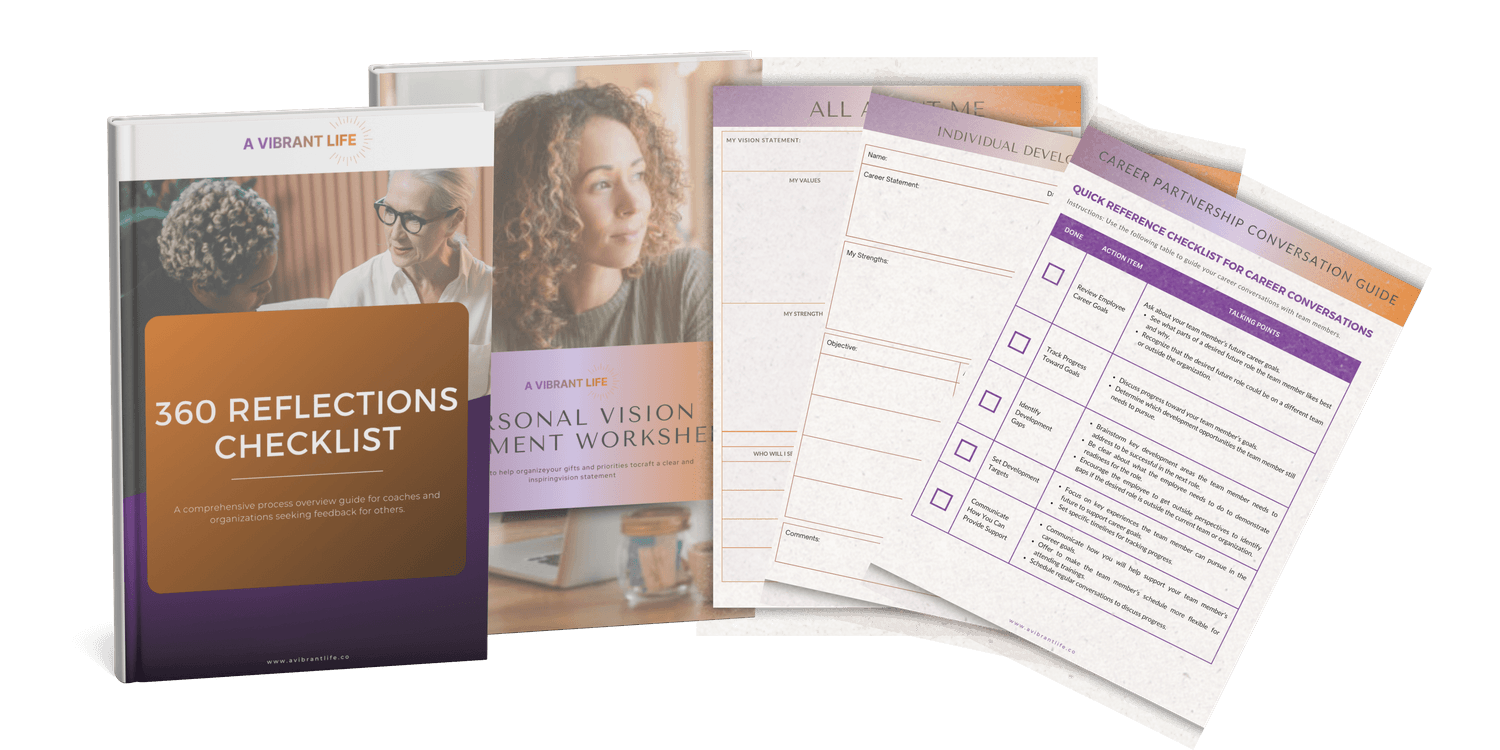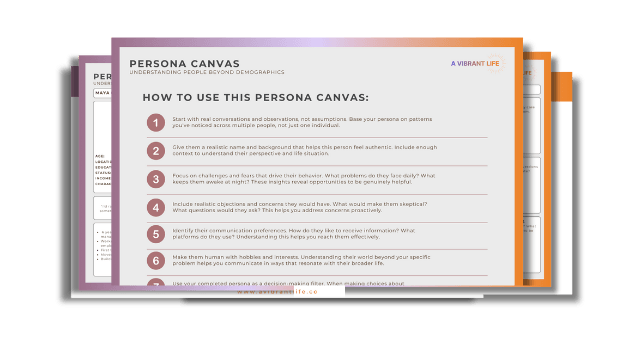Creating Persona Canvases That Actually Help: Beyond Demographics and Assumptions | Vibrant Life
You've probably seen them before—those polished persona profiles with stock photos and perfectly crafted descriptions that look impressive in presentations but somehow never quite capture the people you're trying to reach. Maybe you've even created a few yourself, only to find them gathering digital dust because they felt more like creative writing exercises than useful tools.
The truth is, most persona canvases miss the mark because they focus on the wrong things. They get caught up in surface-level details—age, income, job title—without digging into what drives people's decisions and behaviors. They end up being educated guesses dressed up as insights.
Useful persona canvases are different. They're built on a genuine understanding of the people you're trying to serve, help, or connect with. They capture not just who someone is, but how they think, what keeps them up at night, and what would make their life genuinely better.
What Makes a Persona Canvas Useful?
A useful persona canvas feels like a person because it's grounded in observations and conversations. When you read it, you can practically hear that person talking. You understand their frustrations well enough to spot them in a crowded room, and you know their goals clearly enough to offer something they'd want.
Think of persona canvases as a way to organize what you've learned about the people you serve. They're not meant to be creative fiction, they're meant to be a synthesis of patterns you've observed across multiple interactions and conversations.
The best persona canvases help you make better decisions. When you're trying to figure out how to communicate something, or what features to prioritize, or how to solve a problem, you can ask yourself: "What would Sarah think about this?" And if you've built the persona canvas well, you'll have a good sense of the answer.
The Essential Elements That Matter
Name and Background
Give your persona a name and enough background context to make them feel human. This isn't about creating a detailed life story; it's about establishing enough context to understand their perspective and circumstances.
Demographics
Include the basics, but only the ones that influence how this person thinks and behaves. Age might shape their communication preferences, comfort with technology, career priorities, or life stage concerns. Location could affect their budget, cultural context, or daily challenges. Include demographic details when they genuinely impact the decisions and behaviors you're trying to understand.
Challenges
This is where personas get interesting. What problems does this person face regularly? What makes their day harder than it needs to be? These challenges often reveal opportunities to be genuinely helpful.
Biggest Fears
What keeps them awake at 3 AM? What are they worried about but might not say out loud? Understanding someone's fears helps you approach them with empathy and address concerns they might not even articulate.
Common Objections
What would make this person skeptical about your solution, product, or idea? What questions would they ask? What would make them hesitate? Knowing this helps you address concerns proactively rather than being caught off guard.
Hobbies and Interests
These details help you understand their world beyond the specific problem you're trying to solve. They also reveal how this person likes to spend their time and what kinds of things resonate with them.
Communication Channels
How does this person prefer to receive information? What platforms do they use regularly? Do they prefer email, phone calls, social media, or face-to-face conversations? Understanding their communication preferences helps you reach them effectively and in ways they'll actually pay attention to.
How Persona Canvases Come Together
Building useful persona canvases requires information, not assumptions. The best ones emerge from patterns you notice across multiple conversations, interviews, surveys, or observations.
The Persona Canvas starts with understanding the "real person" — the individual beyond age, income, and job titles. It's a practical tool for capturing what truly matters to your audience, what keeps them awake at night, and what would genuinely improve their life. It looks at their complete world to identify their challenges, objections, and decision-making patterns. Because it's called a canvas, it creates a clear portrait of the people you're trying to reach and serve.
1. Start with Conversation
Talk to people who fit the profile you're trying to understand. Ask about their challenges, goals, and decision-making processes. Listen for emotional language—what frustrates them, what excites them, what worries them.
2. Look for Patterns, Not Individuals
A good persona canvas represents shared characteristics across multiple people, not just one person's specific situation. Look for common themes in how people describe their challenges, goals, and concerns.
3. Focus on Behavior, Not Just Description
Rather than just documenting what someone does, try to understand why they do it. What drives their choices? What influences their decisions? How do they evaluate options?
4. Include Contradictions
People are complicated. Someone might want to save money but also value quality. They might want convenience but also want to feel in control. Good persona canvases capture these tensions rather than oversimplifying.
Common Persona Canvas Pitfalls and How to Avoid Them
The Fantasy Customer Problem
Sometimes persona canvases describe the customer you wish you had rather than the customers you have. These persona canvases are usually too perfect—they love everything about your solution and have no objections or concerns. People are messier than that.
The Demographic Trap
Focusing too heavily on demographics can lead you to assume that people of similar ages or backgrounds think alike. In reality, mindset and circumstances often matter more than demographic categories.
The Static Persona Issue
People change, markets evolve, and what was true six months ago might not be true today. Treat persona canvases as living documents that need regular updates based on new conversations and observations.
The Generic Description Challenge
Vague descriptions like "values quality" or "wants convenience" don't help you make decisions. Be specific about what quality means to this person or what kind of convenience they're actually seeking.
Using Persona Canvases for Better Decision-Making
Once you have a well-crafted persona canvas, use it as a decision-making filter. When you're weighing options or trying to solve problems, consider how your persona would respond.
Communication Decisions
How would this person prefer to receive information? What language would resonate with them? What would make them feel understood rather than sold to?
Product or Service Decisions
What features would matter to this person? What would feel like unnecessary complexity? What would address their concerns?
Content and Marketing Decisions
What topics would this person find genuinely useful? What format would work best for their lifestyle? What would make them want to share something with others?
Customer Experience Decisions
What would make this person's interaction with you smooth and positive? Where might they get frustrated or confused? What would exceed their expectations?
Making Persona Canvases Feel Real
The difference between a useful persona canvas and a filing cabinet decoration is emotional resonance. When you read your persona canvas, you should be able to imagine having a conversation with this person.
Include direct quotes when possible. If someone said, "I just want something that works without me having to think about it," include that exact language. It captures not just the sentiment but the way this person communicates.
Describe their emotional state around the problems you're trying to solve. Are they frustrated? Anxious? Hopeful? Overwhelmed? Understanding their emotional context helps you approach them appropriately.
Consider their broader life context. What else is competing for their attention? What other priorities are they juggling? This helps you understand how your solution fits into their larger picture.
Testing and Refining Your Persona Canvases
Good persona canvases evolve as you learn more about the people you serve. Regularly test your assumptions by having more conversations and observing behavior.
Pay attention to when your persona canvases feel off. If you're surprised by how people respond to something, that's valuable feedback about what you might be missing or misunderstanding.
Update your persona canvases when you notice patterns that don't fit. Maybe you thought your audience was primarily concerned about cost, but conversations reveal they're more worried about reliability. Adjust accordingly.
Beyond Individual Persona Canvases: Understanding Relationships
Sometimes the most important insights come from understanding how different persona canvases interact with each other. The person who makes the decision might not be the person who uses your solution daily. The person with the budget might not be the person with the problem.
Consider who influences your primary persona's decisions. Whose opinion do they value? Who do they need to convince or consult before moving forward?
Coaching Corner: Facilitating Persona Canvas Development Sessions
For coaches, consultants, and team facilitators working with entrepreneurs or professionals exploring new career directions, persona canvas development can be a powerful exercise for validating target markets and understanding ideal clients. This process works best after clients have completed their Empathy Map and conducted conversations with potential customers, clients, or industry contacts. Whether you're helping startup founders clarify their ideal customers or guiding career changers to understand the people they'd like to serve in their new field, persona canvas development builds deeper understanding of your target audience.
Session Preparation
Plan for 2-3 hours for comprehensive persona canvas development. Gather any existing market research, customer interviews, or networking conversations your client has conducted. If possible, encourage clients to bring notes from their Empathy Map exercise and any feedback from potential customers or industry contacts they've spoken with.
Facilitation Flow
Step 1: Information Gathering (30-45 minutes)
Start by having your client share what they've learned from their conversations with potential customers, clients, or industry contacts. Look for both facts and observations about behavior, concerns, and motivations from their Empathy Map work and direct conversations.
Step 2: Pattern Identification (45-60 minutes)
Work together to identify common themes across different conversations and interactions. What challenges came up repeatedly in their customer interviews? What objections or concerns did they hear often? What goals or desires do people consistently mention?
Step 3: Persona Canvas Building (60-90 minutes)
Collaboratively build 1-2 persona canvases based on the patterns identified from their research and conversations. Focus on creating persona canvases that feel authentic and actionable rather than trying to cover every possible customer or client type.
Key Facilitation Questions
"What specific words do customers use when describing this challenge?"
"What would make this person skeptical about our solution?"
"What else is competing for their attention when they're dealing with this problem?"
"How would we recognize this person in a room full of people?"
"What would this person's biggest concern be about working with us?"
Common Challenges and Solutions
Over-Generalization
Teams sometimes create persona canvases that are too broad to be useful. Push for specificity and concrete examples.
Assumption-Based Building
Watch for persona canvases built on what the team thinks rather than what they've observed. Encourage grounding insights in customer interactions.Perfect Customer Syndrome
Teams often create persona canvases that love everything about their solution. Challenge them to include realistic objections and concerns.Feature-Focused Thinking
Keep the focus on the person's world and challenges rather than jumping immediately to product features or solutions.
Making It Actionable
End sessions by identifying specific ways the team will use these persona canvases in upcoming decisions. How will they inform the next campaign, product feature, or customer conversation?
Schedule regular check-ins to discuss what the team is learning about their persona canvases and when updates might be needed.
Moving Forward
When done well, persona canvases become valuable team assets that improve decision-making and help everyone stay focused on what matters to the people you're trying to help. They transform abstract concepts like "customer needs" into concrete, actionable insights.
The next time you're trying to understand your audience better, consider creating a persona canvas. But start with conversations, focus on genuine challenges and concerns, and resist the urge to make it more polished than useful. Your future self—and your customers—will thank you for the effort.
Understanding the full experience of your users, not just their functional needs but their emotional journey and underlying concerns.

About Us
We are a community of practitioners & experts, passionate about empowering individuals & organizations with tools for growth, well-being, and transformation.

Explore Our Catalog of Transformative Products
Discover our range of expertly crafted products designed to help you achieve your goals and live a more vibrant life. Whether you're looking to advance your career, find balance, or create a thriving environment, our catalog has something for everyone.

Discover Our Free Resources
Access our collection of valuable free tools, guides, and resources designed to support your personal growth journey. From starter templates to educational content, we're here to help you get started without any cost.
GET EXCLUSIVE ACCESS
Collaborate and Grow with Our HR and Coaching Community
Get exclusive content and resources designed to help you thrive both personally and professionally. Become a member of the A Vibrant Life community and gain access to expert insights, practical strategies, and a supportive network of like-minded individuals.
Your privacy is important to us. We promise to keep your email safe and never spam.

Ready to take the next step towards a vibrant life and fulfilling career?
Explore our transformative solutions tailored to meet you where you are and guide you to where you want to be.








